The Star-Spangled Banner
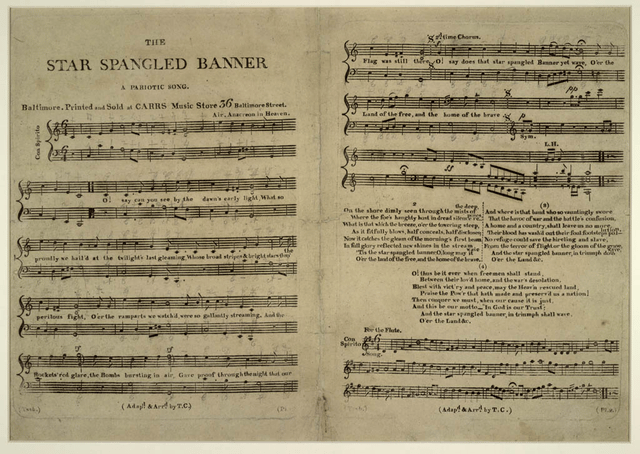
The Star-Spangled Banner

| Lyrics | Francis Scott Key, 1814 |
|---|---|
| Music | John Stafford Smith, c. 1773 |
| Adopted | March 3, 1931[1] |
| Audio sample | |
"The Star-Spangled Banner Defence of Fort M'Henry,[2] a poem written on September 14, 1814, by the then 35-year-old lawyer and amateur poet Francis Scott Key after witnessing the bombardment of Fort McHenry by British ships of the Royal Navy in Baltimore Harbor during the Battle of Baltimore in the War of 1812. Key was inspired by the large U.S. flag, with 15 stars and 15 stripes, known as the Star-Spangled Banner, flying triumphantly above the fort during the U.S. victory.
The poem was set to the tune of a popular British song written by John Stafford Smith for the Anacreontic Society, a men's social club in London. "To Anacreon in Heaven" (or "The Anacreontic Song"), with various lyrics, was already popular in the United States. This setting, renamed "The Star-Spangled Banner", soon became a well-known U.S. patriotic song. With a range of 19 semitones, it is known for being very difficult to sing. Although the poem has four stanzas, only the first is commonly sung today.
"The Star-Spangled Banner" was recognized for official use by the United States Navy in 1889, and by U.S. President Woodrow Wilson in 1916, and was made the national anthem by a congressional resolution on March 3, 1931 (46 Stat. 1508, codified at 36 U.S.C. § 301 [29] ), which was signed by President Herbert Hoover.
Before 1931, other songs served as the hymns of U.S. officialdom.
"Hail, Columbia" served this purpose at official functions for most of the 19th century. "My Country, 'Tis of Thee", whose melody is identical to "God Save the Queen", the United Kingdom's national anthem,[3] also served as a de facto national anthem.[4] Following the War of 1812 and subsequent U.S. wars, other songs emerged to compete for popularity at public events, among them "America the Beautiful", which itself was being considered before 1931, as a candidate to become the national anthem of the United States.[5]
| Lyrics | Francis Scott Key, 1814 |
|---|---|
| Music | John Stafford Smith, c. 1773 |
| Adopted | March 3, 1931[1] |
| Audio sample | |
Early history
Francis Scott Key's lyrics
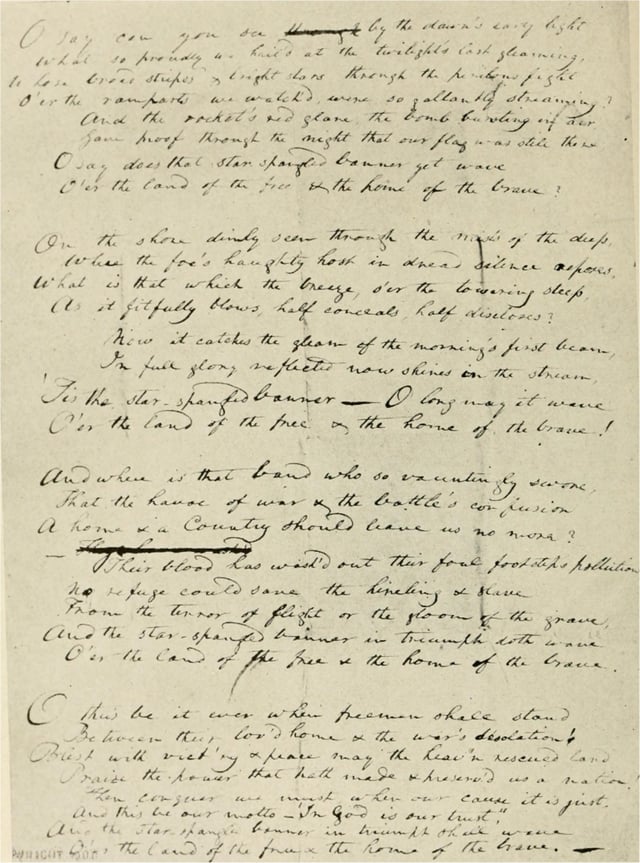
Francis Scott Key's original manuscript copy of his "Defence of Fort M'Henry" poem. It is now on display at the Maryland Historical Society.
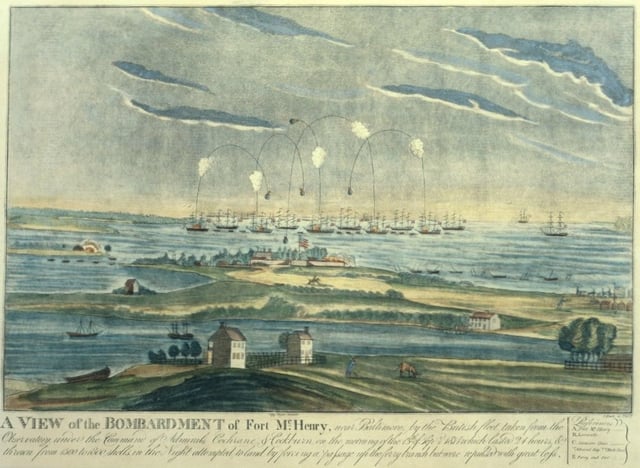
An artist's rendering of the battle at Fort McHenry
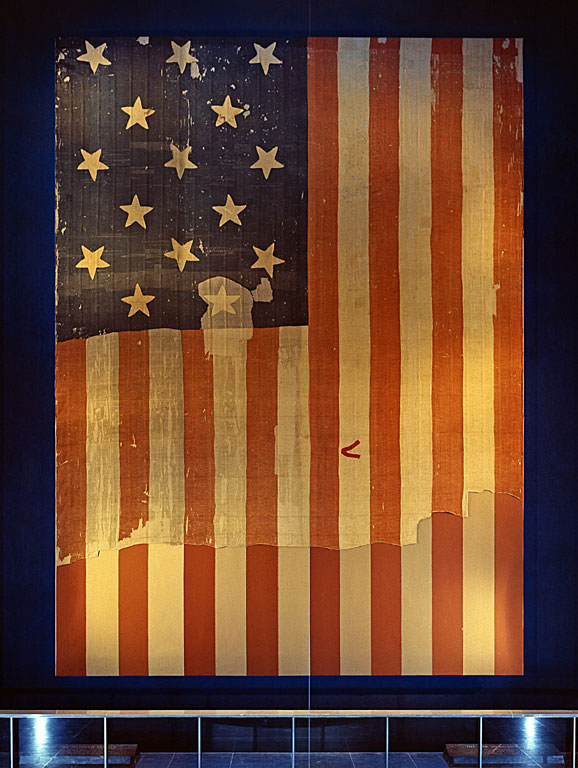
The 15-star, 15-stripe "Star-Spangled Banner" that inspired the poem
On September 3, 1814, following the Burning of Washington and the Raid on Alexandria, Francis Scott Key and John Stuart Skinner set sail from Baltimore aboard the ship HMS Minden, flying a flag of truce on a mission approved by President James Madison. Their objective was to secure an exchange of prisoners, one of whom was William Beanes, the elderly and popular town physician of Upper Marlboro and a friend of Key's who had been captured in his home. Beanes was accused of aiding the arrest of British soldiers. Key and Skinner boarded the British flagship HMS Tonnant on September 7 and spoke with Major General Robert Ross and Vice Admiral Alexander Cochrane over dinner while the two officers discussed war plans. At first, Ross and Cochrane refused to release Beanes but relented after Key and Skinner showed them letters written by wounded British prisoners praising Beanes and other Americans for their kind treatment.
Because Key and Skinner had heard details of the plans for the attack on Baltimore, they were held captive until after the battle, first aboard HMS Surprise and later back on HMS Minden. After the bombardment, certain British gunboats attempted to slip past the fort and effect a landing in a cove to the west of it, but they were turned away by fire from nearby Fort Covington, the city's last line of defense.
During the rainy night, Key had witnessed the bombardment and observed that the fort's smaller "storm flag" continued to fly, but once the shell and Congreve rocket[6] barrage had stopped, he would not know how the battle had turned out until dawn. On the morning of September 14, the storm flag had been lowered and the larger flag had been raised.
During the bombardment, HMS Terror and HMS Meteor
Key was inspired by the U.S. victory and the sight of the large U.S. flag flying triumphantly above the fort. This flag, with fifteen stars and fifteen stripes, had been made by Mary Young Pickersgill together with other workers in her home on Baltimore's Pratt Street. The flag later came to be known as the Star-Spangled Banner and is today on display in the National Museum of American History, a treasure of the Smithsonian Institution. It was restored in 1914 by Amelia Fowler, and again in 1998 as part of an ongoing conservation program.
Aboard the ship the next day, Key wrote a poem on the back of a letter he had kept in his pocket.
At twilight on September 16, he and Skinner were released in Baltimore.
He completed the poem at the Indian Queen Hotel, where he was staying, and titled it "Defence of Fort M'Henry".
It was first published nationally in The Analectic Magazine.[7][8]
Much of the idea of the poem, including the flag imagery and some of the wording, is derived from an earlier song by Key, also set to the tune of "The Anacreontic Song". The song, known as "When the Warrior Returns",[9] was written in honor of Stephen Decatur and Charles Stewart on their return from the First Barbary War.
Absent elaboration by Francis Scott Key prior to his death in 1843, some have speculated more recently about the meaning of phrases or verses, particularly the phrase "the hireling and slave" from the third stanza.
According to British historian Robin Blackburn, the phrase allude to the thousands of ex-slaves in the British ranks organized as the Corps of Colonial Marines, who had been liberated by the British and demanded to be placed in the battle line "where they might expect to meet their former masters."[10] Mark Clague, a professor of musicology at the University of Michigan, argues that the "middle two verses of Key's lyric vilify the British enemy in the War of 1812" and "in no way glorifies or celebrates slavery."[11] Clague writes that "For Key... the British mercenaries were scoundrels and the Colonial Marines were traitors who threatened to spark a national insurrection."[11] This harshly anti-British nature of Verse 3 led to its omission in sheet music in World War I, when the British and the U.S. were allies.[11] Responding to the assertion of writer Jon Schwarz of The Intercept that the song is a "celebration of slavery,"[12] Clague said that: "The reference to slaves is about the use and in some sense the manipulation, of black Americans to fight for the British, with the promise of freedom. The American forces included African-Americans as well as whites. The term 'freemen,' whose heroism is celebrated in the fourth stanza, would have encompassed both."[13]
Others suggest that "Key may have intended the phrase as a reference to the British Navy's practice of impressment (kidnapping sailors and forcing them to fight in defense of the crown), or as a semi-metaphorical slap at the British invading force as a whole (which also included a large number of mercenaries)."[14]
John Stafford Smith's music
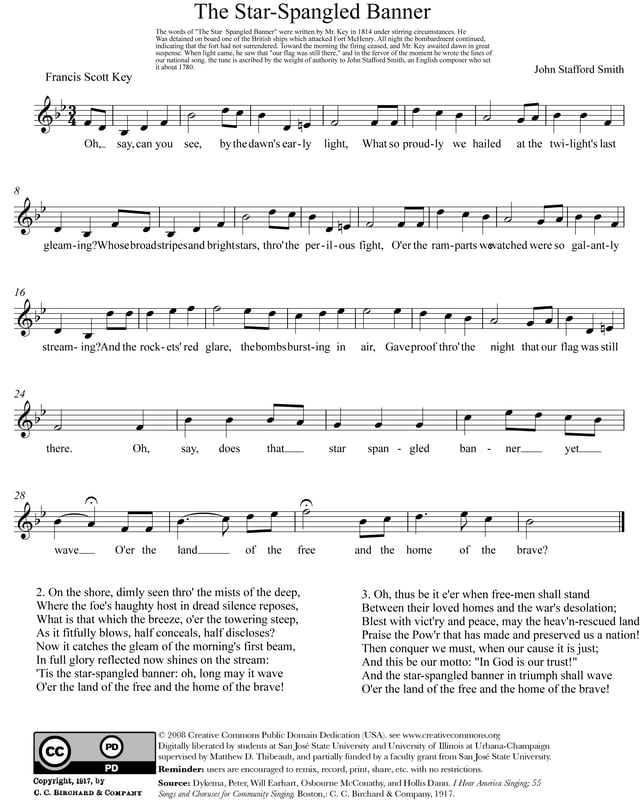
Sheet music version Play
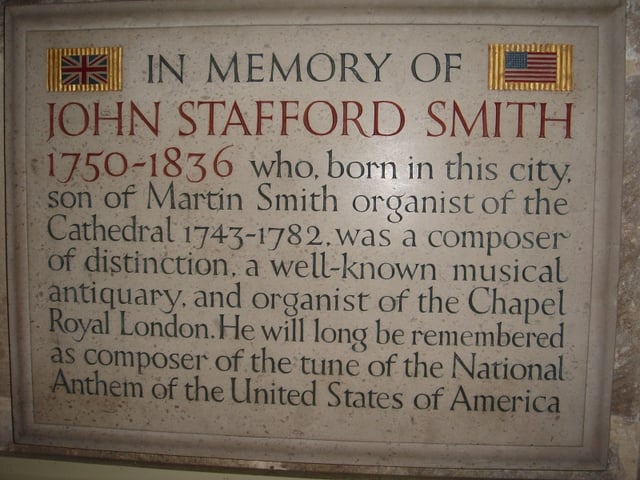
A memorial to John Stafford Smith in Gloucester Cathedral, Gloucester, England
Key gave the poem to his brother-in-law Joseph H. Nicholson who saw that the words fit the popular melody "The Anacreontic Song", by English composer John Stafford Smith. This was the official song of the Anacreontic Society, an 18th-century gentlemen's club of amateur musicians in London. Nicholson took the poem to a printer in Baltimore, who anonymously made the first known broadside printing on September 17; of these, two known copies survive.
On September 20, both the Baltimore Patriot and The American printed the song, with the note "Tune: Anacreon in Heaven". The song quickly became popular, with seventeen newspapers from Georgia to New Hampshire printing it. Soon after, Thomas Carr of the Carr Music Store in Baltimore published the words and music together under the title "The Star Spangled Banner", although it was originally called "Defence of Fort M'Henry". Thomas Carr's arrangement introduced the raised fourth which became the standard deviation from "The Anacreontic Song".[15] The song's popularity increased and its first public performance took place in October when Baltimore actor Ferdinand Durang sang it at Captain McCauley's tavern. Washington Irving, then editor of the Analectic Magazine
By the early 20th century, there were various versions of the song in popular use.
Seeking a singular, standard version, President Woodrow Wilson tasked the U.S.
Bureau of Education with providing that official version.
In response, the Bureau enlisted the help of five musicians to agree upon an arrangement.
Those musicians were Walter Damrosch, Will Earhart, Arnold J. Gantvoort, Oscar Sonneck and John Philip Sousa. The standardized version that was voted upon by these five musicians premiered at Carnegie Hall on December 5, 1917, in a program that included Edward Elgar's Carillon and Gabriel Pierné's The Children's Crusade. The concert was put on by the Oratorio Society of New York and conducted by Walter Damrosch.[16] An official handwritten version of the final votes of these five men has been found and shows all five men's votes tallied, measure by measure.[17]
National anthem
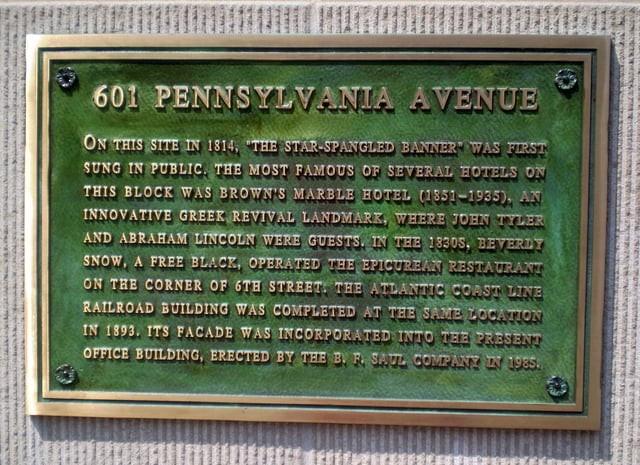
Commemorative plaque in Washington, D.C. marking the site at 601 Pennsylvania Avenue where "The Star-Spangled Banner" was first publicly sung
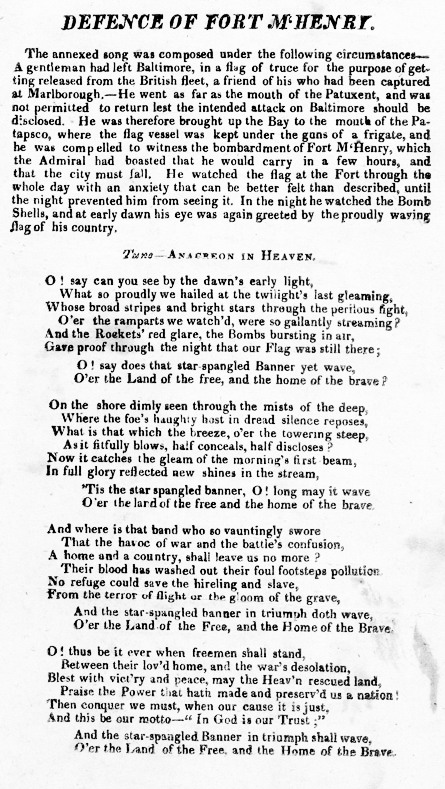
One of two surviving copies of the 1814 broadside printing of the "Defence of Fort M'Henry", a poem that later became the lyrics of "The Star-Spangled Banner", the national anthem of the United States.
The song gained popularity throughout the 19th century and bands played it during public events, such as Independence Day celebrations.
A plaque displayed at Fort Meade, South Dakota, claims that the idea of making "The Star Spangled Banner" the national anthem began on their parade ground in 1892.
Colonel Caleb Carlton, post commander, established the tradition that the song be played "at retreat and at the close of parades and concerts."
Carlton explained the custom to Governor Sheldon of South Dakota who "promised me that he would try to have the custom established among the state militia."
Carlton wrote that after a similar discussion, Secretary of War Daniel E. Lamont issued an order that it "be played at every Army post every evening at retreat."[18]
In 1899, the U.S.
Navy officially adopted "The Star-Spangled Banner".[19] In 1916, President Woodrow Wilson ordered that "The Star-Spangled Banner" be played at military[19] and other appropriate occasions. The playing of the song two years later during the seventh-inning stretch of Game One of the 1918 World Series, and thereafter during each game of the series is often cited as the first instance that the anthem was played at a baseball game,[20] though evidence shows that the "Star-Spangled Banner" was performed as early as 1897 at opening day ceremonies in Philadelphia and then more regularly at the Polo Grounds in New York City beginning in 1898. In any case, the tradition of performing the national anthem before every baseball game began in World War II.[21]
On April 10, 1918, John Charles Linthicum, U.S. congressman from Maryland, introduced a bill to officially recognize "The Star-Spangled Banner" as the national anthem.[22] The bill did not pass.[22] On April 15, 1929, Linthicum introduced the bill again, his sixth time doing so.[22] On November 3, 1929, Robert Ripley drew a panel in his syndicated cartoon, Ripley's Believe it or Not!, saying "Believe It or Not, America has no national anthem".[23]
In 1930, Veterans of Foreign Wars started a petition for the United States to officially recognize "The Star-Spangled Banner" as the national anthem.[24] Five million people signed the petition.[24] The petition was presented to the United States House Committee on the Judiciary on January 31, 1930.[25] On the same day, Elsie Jorss-Reilley and Grace Evelyn Boudlin sang the song to the Committee to refute the perception that it was too high pitched for a typical person to sing.[26] The Committee voted in favor of sending the bill to the House floor for a vote.[27] The House of Representatives passed the bill later that year.[28] The Senate passed the bill on March 3, 1931.[28] President Herbert Hoover signed the bill on March 4, 1931, officially adopting "The Star-Spangled Banner" as the national anthem of the United States of America.[1] As currently codified, the United States Code states that "[t]he composition consisting of the words and music known as the Star-Spangled Banner is the national anthem."[29] Although the National Anthem officially comprises all four stanzas of the poem, only the first stanza is generally sung, and the other three are much lesser-known.
Modern history
Performances
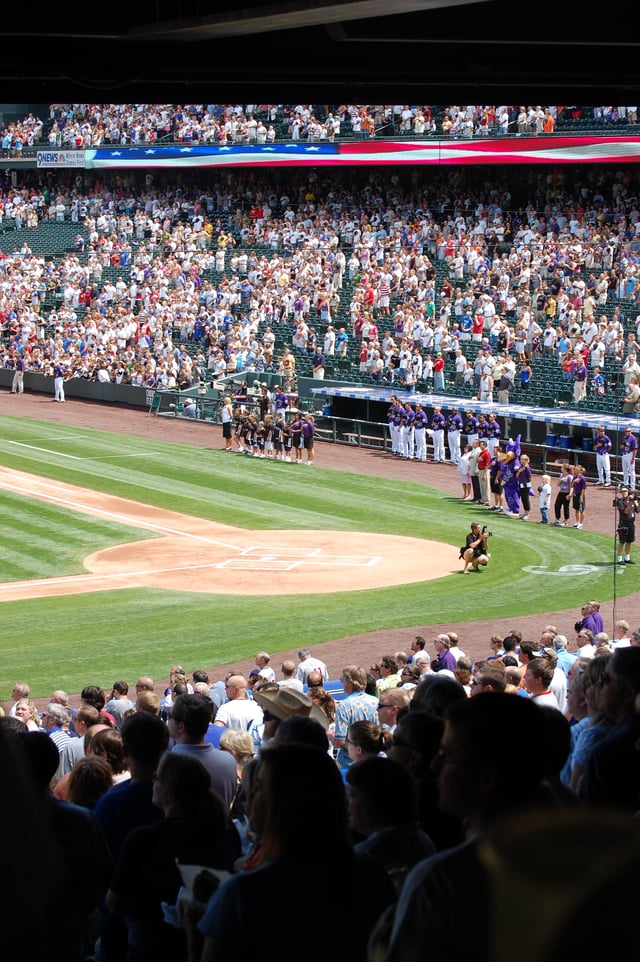
Crowd performing the U.S. national anthem before a baseball game at Coors Field
The song is notoriously difficult for nonprofessionals to sing because of its wide range – a 12th. Humorist Richard Armour referred to the song's difficulty in his book It All Started With Columbus:
In an attempt to take Baltimore, the British attacked Fort McHenry, which protected the harbor.
Bombs were soon bursting in air, rockets were glaring, and all in all it was a moment of great historical interest.
During the bombardment, a young lawyer named Francis Off Key [sic] wrote "The Star-Spangled Banner", and when, by the dawn's early light, the British heard it sung, they fled in terror.[30]
Professional and amateur singers have been known to forget the words, which is one reason the song is sometimes pre-recorded and lip-synced.
Other times the issue is avoided by having the performer(s) play the anthem instrumentally instead of singing it.
The pre-recording of the anthem has become standard practice at some ballparks, such as Boston's Fenway Park, according to the SABR publication The Fenway Project.[31]
"The Star-Spangled Banner" has been performed regularly at the beginning of NFL games since the end of WWII by order of NFL commissioner Elmer Layden, according to History.com.[32] According to same article, the song has been intermittently performed at baseball games since after WWI It has also been popular as performed by orchestra or soloists at other public gatherings. The National Hockey League and Major League Soccer both require venues in both the U.S. and Canada to perform both the Canadian and U.S. national anthems at games that involve teams from both countries (with the "away" anthem being performed first).[33] It is also usual for both U.S. and Canadian anthems (done in the same way as the NHL and MLS) to be played at Major League Baseball and National Basketball Association games involving the Toronto Blue Jays and the Toronto Raptors (respectively), the only Canadian teams in those two major U.S. sports leagues, and in All Star Games on the MLB, NBA, and NHL. The Buffalo Sabres of the NHL, which play in a city on the Canada–US border and have a substantial Canadian fan base, play both anthems before all home games regardless of where the visiting team is based.[34]
Two especially unusual performances of the song took place in the immediate aftermath of the United States September 11 attacks. On September 12, 2001, Elizabeth II, the Queen of the United Kingdom, broke with tradition and allowed the Band of the Coldstream Guards to perform the anthem at Buckingham Palace, London, at the ceremonial Changing of the Guard, as a gesture of support for Britain's ally.[35] The following day at a St. Paul's Cathedral memorial service, the Queen joined in the singing of the anthem, an unprecedented occurrence.[36]
200th anniversary celebrations
The 200th anniversary of the "Star-Spangled Banner" occurred in 2014 with various special events occurring throughout the United States.
A particularly significant celebration occurred during the week of September 10–16 in and around Baltimore, Maryland.
Highlights included playing of a new arrangement of the anthem arranged by John Williams and participation of President Obama on Defender's Day, September 12, 2014, at Fort McHenry.[37] In addition, the anthem bicentennial included a youth music celebration[38] including the presentation of the National Anthem Bicentennial Youth Challenge winning composition written by Noah Altshuler.
Adaptations
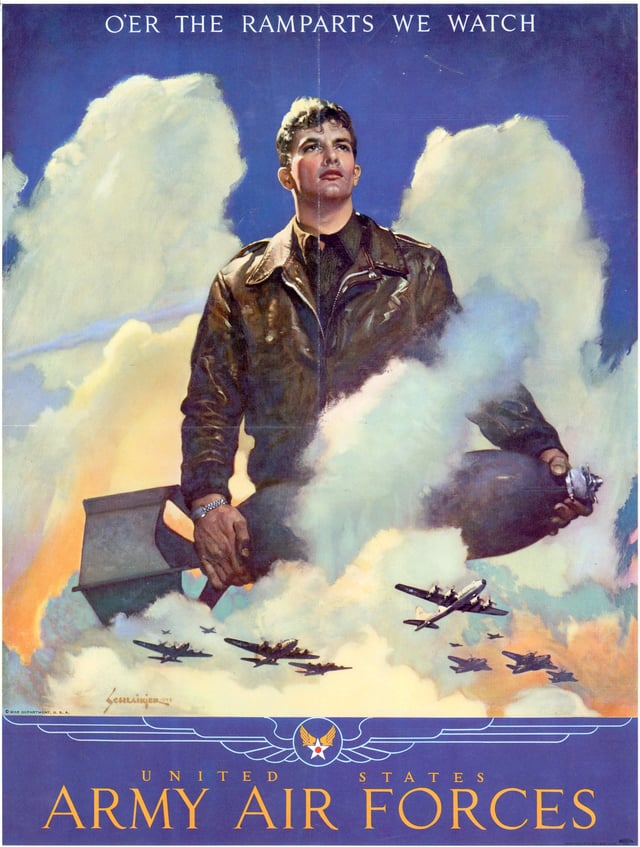
O'er the ramparts we watch in a 1945 United States Army Air Forces poster
The first popular music performance of the anthem heard by the mainstream U.S. was by Puerto Rican singer and guitarist José Feliciano. He created a nationwide uproar when he strummed a slow, blues-style rendition of the song[39] at Tiger Stadium in Detroit before game five of the 1968 World Series, between Detroit and St. Louis.[40] This rendition started contemporary "Star-Spangled Banner" controversies. The response from many in the Vietnam War-era U.S. was generally negative. Despite the controversy, Feliciano's performance opened the door for the countless interpretations of the "Star-Spangled Banner" heard in the years since.[41] One week after Feliciano's performance, the anthem was in the news again when U.S. athletes Tommie Smith and John Carlos lifted controversial raised fists at the 1968 Olympics while the "Star-Spangled Banner" played at a medal ceremony. Another famous instrumental interpretation is Jimi Hendrix's version, which was a set-list staple from autumn 1968 until his death in September 1970, including a famous rendition at the Woodstock music festival in 1969. Incorporating sonic effects to emphasize the "rockets' red glare", and "bombs bursting in air", it became a late-1960s emblem.
Marvin Gaye gave a soul-influenced performance at the 1983 NBA All-Star Game and Whitney Houston gave a soulful rendition before Super Bowl XXV in 1991, which was released as a single that charted at number 20 in 1991 and number 6 in 2001 (along with José Feliciano, the only times the national anthem has been on the Billboard Hot 100Hot 100]]). In 1993, Kiss did an instrumental rock version as the closing track on their album, Roseanne Barr gave a controversial performance of the anthem at a San Diego Padres baseball game at Jack Murphy Stadium on July 25, 1990. The comedian belted out a screechy rendition of the song, and afterward, she mocked ballplayers by spitting and grabbing her crotch as if adjusting a protective cup. The performance offended some, including the sitting U.S. President, George H. W. Bush.[42] Sufjan Stevens has frequently performed the "Star-Spangled Banner" in live sets, replacing the optimism in the end of the first verse with a new coda that alludes to the divisive state of the nation today. David Lee Roth both referenced parts of the anthem and played part of a hard rock rendition of the anthem on his song, "Yankee Rose" on his 1986 solo album, Eat 'Em and Smile. Steven Tyler also caused some controversy in 2001 (at the Indianapolis 500, to which he later issued a public apology) and again in 2012 (at the AFC Championship Game) with a cappella renditions of the song with changed lyrics.[43] In 2016, Aretha Franklin performed a rendition before the nationally-televised Minnesota Vikings-Detroit Lions Thanksgiving Day game lasting more than four minutes and featuring a host of improvizations. It would be one of Franklin's last public appearances before her 2018 death.[44] Black Eyed Peas-singer Fergie gave a controversial performance of the anthem in 2018. Critics likened her rendition to a jazzy "sexed-up" version of the anthem, which was considered highly inappropriate, with her performance compared to that of Marilyn Monroe's iconic performance of Happy Birthday, Mr. President. Fergie later apologized for her performance of the song, citing that ''I'm a risk taker artistically, but clearly this rendition didn't strike the intended tone".[45]
A version of Aerosmith's Joe Perry and Brad Whitford playing part of the song can be heard at the end of their version of "Train Kept A-Rollin'" on the Rockin' the Joint album. The band Boston gave an instrumental rock rendition of the anthem on their Greatest Hits album. The band Crush 40 made a version of the song as opening track from the album Thrill of the Feel
In March 2005, a government-sponsored program, the National Anthem Project, was launched after a Harris Interactive poll showed many adults knew neither the lyrics nor the history of the anthem.[46]
Lyrics
Additional Civil War period lyrics
Eighteen years after Key's death, and in indignation over the start of the American Civil War, Oliver Wendell Holmes, Sr.[48] added a fifth stanza to the song in 1861, which appeared in songbooks of the era.[49]
When our land is illumined with Liberty's smile, If a foe from within strike a blow at her glory, Down, down with the traitor that dares to defile The flag of her stars and the page of her story!
By the millions unchained, who our birthright have gained, We will keep her bright blazon forever unstained!
And the Star-Spangled Banner in triumph shall wave While the land of the free is the home of the brave.
Alternative lyrics
References in film, television, literature
Several films have their titles taken from the song's lyrics.
These include two films titled Dawn's Early Light (2000[52] and 2005);[53] two made-for-TV features titled By Dawn's Early Light (1990[54] and 2000);[55] two films titled So Proudly We Hail (1943[56] and 1990);[57] a feature film (1977)[58] and a short (2005)[59] titled Twilight's Last Gleaming; and four films titled Home of the Brave (1949,[60] 1986,[61] 2004,[62] and 2006).[63] A 1936 short titled The Song of a Nation from Warner Brothers shows a version of the origin of the song.[64]
Customs and federal law
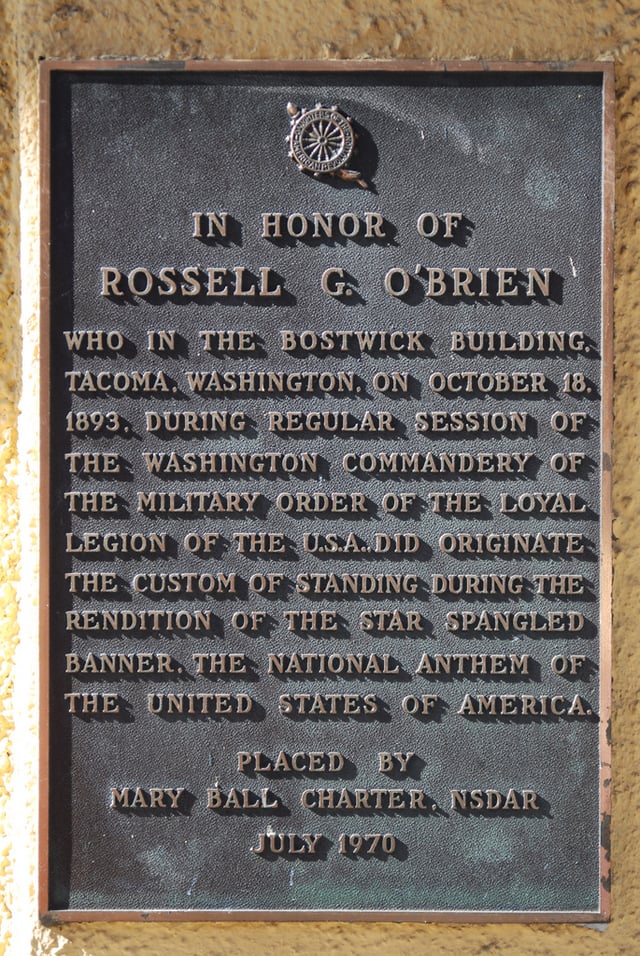
Plaque detailing how the custom of standing during the U.S. national anthem came about in Tacoma, Washington, on October 18, 1893, in the Bostwick building
When the U.S. national anthem was first recognized by law in 1931, there was no prescription as to behavior during its playing.
On June 22, 1942, the law was revised indicating that those in uniform should salute during its playing, while others should simply stand at attention, men removing their hats.
The same code also required that women should place their hands over their hearts when the flag is displayed during the playing of the national anthem, but not if the flag was not present.
On December 23, 1942, the law was again revised instructing men and women to stand at attention and face in the direction of the music when it was played.
That revision also directed men and women to place their hands over their hearts only if the flag was displayed.
Those in uniform were required to salute.
On July 7, 1976, the law was simplified.
Men and women were instructed to stand with their hands over their hearts, men removing their hats, irrespective of whether or not the flag was displayed and those in uniform saluting.
On August 12, 1998, the law was rewritten keeping the same instructions, but differentiating between "those in uniform" and "members of the Armed Forces and veterans" who were both instructed to salute during the playing whether or not the flag was displayed.
Because of the changes in law over the years and confusion between instructions for the Pledge of Allegiance versus the National Anthem, throughout most of the 20th century many people simply stood at attention or with their hands folded in front of them during the playing of the Anthem, and when reciting the Pledge they would hold their hand (or hat) over their heart.
After 9/11, the custom of placing the hand over the heart during the playing of the national anthem became nearly universal.[65][66][67]
Since 1998, federal law (viz., the United States Code 36 U.S.C. § 301 [29] ) states that during a rendition of the national anthem, when the flag is displayed, all present including those in uniform should stand at attention; Non-military service individuals should face the flag with the right hand over the heart; Members of the Armed Forces and veterans who are present and not in uniform may render the military salute; military service persons not in uniform should remove their headdress with their right hand and hold the headdress at the left shoulder, the hand being over the heart; and Members of the Armed Forces and veterans who are in uniform should give the military salute at the first note of the anthem and maintain that position until the last note. The law further provides that when the flag is not displayed, all present should face toward the music and act in the same manner they would if the flag were displayed. Military law requires all vehicles on the installation to stop when the song is played and all individuals outside to stand at attention and face the direction of the music and either salute, in uniform, or place the right hand over the heart, if out of uniform. The law was amended in 2008, and since allows military veterans to salute out of uniform, as well.[68][69]
The text of 36 U.S.C. § 301 [29] is suggestive and not regulatory in nature. Failure to follow the suggestions is not a violation of the law. This behavioral requirement for the national anthem is subject to the same First Amendment controversies that surround the Pledge of Allegiance.[70] For example, Jehovah's Witnesses do not sing the national anthem, though they are taught that standing is an "ethical decision" that individual believers must make based on their "conscience."[71][72][73]
Protests
1968 Olympics Black Power salute
The 1968 Olympics Black Power salute was a political demonstration conducted by African-American athletes Tommie Smith and John Carlos during their medal ceremony at the 1968 Summer Olympics in the Olympic Stadium in Mexico City. After having won gold and bronze medals respectively in the 200-meter running event, they turned on the podium to face their flags, and to hear the American national anthem, "The Star-Spangled Banner". Each athlete raised a black-gloved fist, and kept them raised until the anthem had finished. In addition, Smith, Carlos, and Australian silver medalist Peter Norman all wore human rights badges on their jackets. In his autobiography, Silent Gesture, Smith stated that the gesture was not a "Black Power" salute, but a "human rights salute". The event is regarded as one of the most overtly political statements in the history of the modern Olympic Games.[74]
2016 protests
Politically motivated protests of the national anthem began in the National Football League after San Francisco 49ers quarterback Colin Kaepernick knelt during the anthem, as opposed to the tradition of standing, in response to police brutality in America, before his team's third preseason game of 2016. Kaepernick sat during the first two preseason games, but he went unnoticed.[75]
NAACP call to remove the national anthem
In November 2017, the California Chapter of the NAACP called on Congress to remove "The Star-Spangled Banner" as the national anthem. Alice Huffman, California NAACP president said: "it's racist; it doesn't represent our community, it's anti-black."[76] The third stanza of the anthem, which is rarely sung and few know, contains the words, "No refuge could save the hireling and slave, From the terror of flight, or the gloom of the grave:", which some interpret as racist. The organization was still seeking a representative to sponsor the legislation in Congress at the time of their announcement.
Translations
As a result of immigration to the United States and the incorporation of non-English speaking people into the country, the lyrics of the song have been translated into other languages.
In 1861, it was translated into German.[77] The Library of Congress also has record of a Spanish-language version from 1919.[78] It has since been translated into Hebrew[79] and Yiddish by Jewish immigrants,[80] Latin American Spanish (with one version popularized during immigration reform protests in 2006),[81] French by Acadians of Louisiana,[82] Samoan,[83] and Irish.[84] The third verse of the anthem has also been translated into Latin.[85]
Media
 (1940) | 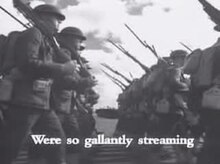 (1944) |
See also
In God We Trust
O Say Can You See (disambiguation)
By the Dawn's Early Light (disambiguation)
What So Proudly We Hailed (disambiguation)
Twilight's Last Gleaming (disambiguation)
Whose Broad Stripes and Bright Stars (disambiguation)
Through the Perilous Fight (disambiguation)
Rockets' Red Glare (disambiguation)
Bombs Bursting in Air (disambiguation)
Gave Proof Through the Night (disambiguation)
Land of the Free (disambiguation)
Home of the Brave (disambiguation)
